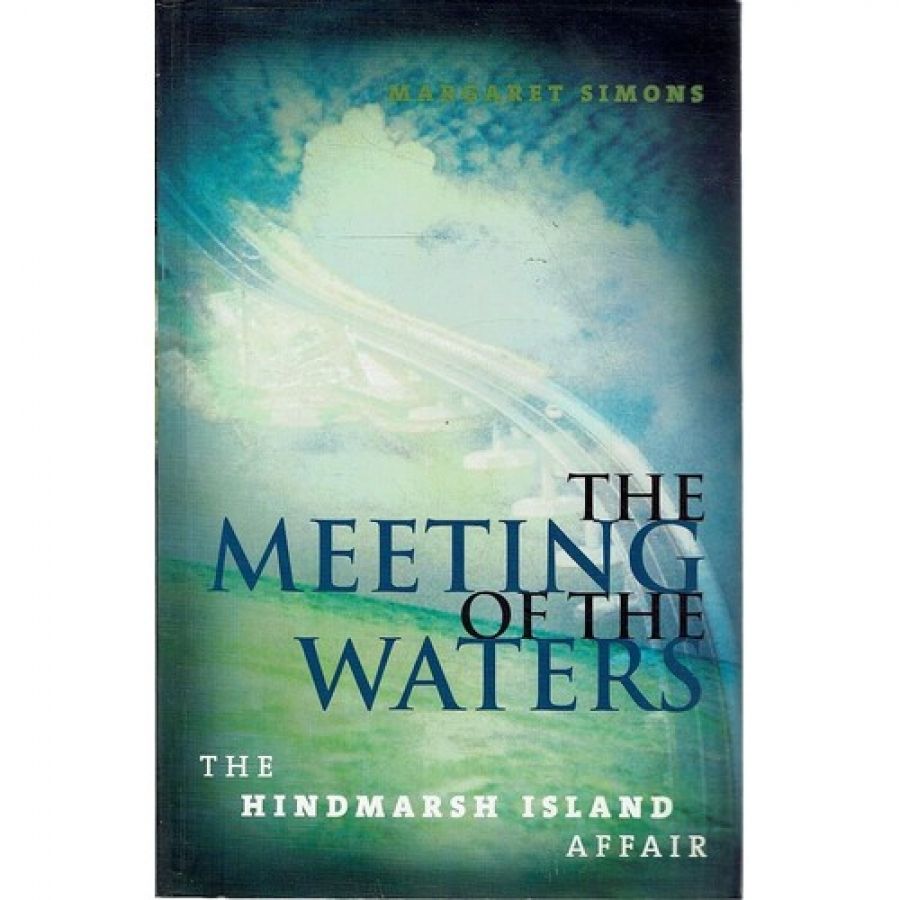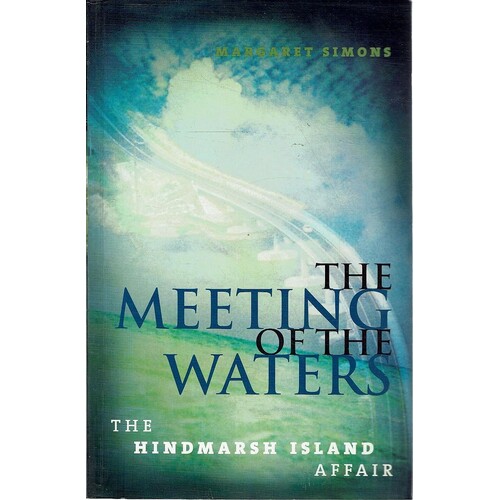
- Free Article: No
- Contents Category: Non-fiction
- Review Article: Yes
- Article Title: A Thousand Small Tragedies
- Online Only: No
- Custom Highlight Text:
Reading this new book in the cold midwinter of 2003, I stopped one night to watch the news; the lead story was about the newly resumed dredging operations at the Murray Mouth, an hour or two south-east of Adelaide. The dredging is a temporary measure, a kind of emergency surgery to stop the river mouth silting up and closing altogether.
- Book 1 Title: The Meeting Of The Waters
- Book 1 Subtitle: The Hindmarsh Island Affair
- Book 1 Biblio: Hodder, $39.95 pb, 528pp
- Book 1 Cover Small (400 x 600):

- Book 1 Cover (800 x 1200):

Two hundred years of interference are coming home to roost in an environmental disaster. And Margaret Simons’s book contains some harsh implications for what this might mean to the Ngarrindjeri people, the heart of whose culture is here at the Murray Mouth, and the unique geographical formations around it. As Ngarrindjeri man George Trevorrow patiently but fruitlessly explained to the Hindmarsh Island Royal Commission in 1995: ‘We cannot, as Aboriginal people, separate environment and culture. They go hand-in-hand.’
Simons, however, only touches directly once or twice on this matter of the actual damage to the river. Her subject is the battle over the building of the Hindmarsh Island Bridge, for which the local council had begun to agitate in the mid-1980s and which was finally completed in March 2001. Simons’s summary of the story in her ‘Prelude’ is a model of succinctness:
In the early 1990s there was a plan to build a bridge from Goolwa [on the mainland] to Hindmarsh Island, but Aboriginal women claimed the island was special to them for reasons that could not be revealed. They applied to the Federal Government for an order prohibiting the bridge. As part of this process some of the women’s secrets were written down and sealed in two envelopes marked ‘Confidential: to be read by women only’. The women were successful. The Federal Government banned the bridge.
About a year later another group of Aboriginal women came forward and said the claim of what had become known as ‘secret women’s business’ was a hoax. A Royal Commission was called. In December 1995 it found that the secret women’s business was a fabrication ... In one way this book is written from the perspective of that moment – when the women were found to be liars, and a set of stories about the land was dismissed.
What Simons leaves out of this summary but sketches into her text is the rapid shifting-around of money and power in the background: economic boom and slump; the collapse of the State Bank of South Australia in 1991 and the fall of the Bannon Labor Government the following year; the effect that the Mabo decision of 1993 had on Australia’s white conservative landowners, businessmen and politicians; and the rapid growth and change in legislation throughout the 1980s and 1990s, at state and federal level, to do with Aboriginal issues and rights.
The summary account quoted above, ending where it does, also leaves out the counter-punchline of the book, in which the Chapmans’ court action against several of the central figures in the Hindmarsh Island affair saw Justice von Doussa of the High Court, in August of 2001, deliver a judgement dismissing the Chapmans’ claims and containing clear, severe and specific criticisms of the findings of the Royal Commission. The claims rested, said von Doussa, on the question of whether the ‘secret women’s business’ had been fabricated, and he was not convinced that it had.
The Hindmarsh Island story has now been going on, one way or another, for fifteen years. The publication of The Meeting of the Waters will no doubt generate a new phase in the debate; the book offers several pieces of new evidence that at least some of the ‘women’s business’ was genuine, and – more damagingly – shows how much of this evidence fell, or was allowed to drop, through the coarse net of the Royal Commission.
Simons’s patient piecing together of her material – interviews, evidence, government and newspaper reports, legal judgements – occasionally becomes hard to slog through. It’s an extraordinarily complex story, partly because of the kaleidoscopic shifts in the political and economic background, partly because it goes on for so long, and partly because it has a bewildering array of characters – and they do not, unlike the characters in fiction, weave themselves in a shapely way through the entire narrative. As it is, says Simons:
they walk in and walk out, make gestures and decisions that change the course of events, and in each case the background must be sketched in if what they do and why they do it is to be understood.
Musing on this cast of thousands again much later in the book, she says:
There are so many voices, all singing their own songs with such conviction ... almost everyone is infected with a sense of wounded righteousness, and sometimes it seems like a thousand small tragedies harnessed together.
Certainly, it was not just a simple matter, though it often looked in the press as if it were, of people taking one ‘side’ or the other; intense rivalries and antipathies went on internally on both sides of the debate. Generally speaking, though, conservative white males – politicians, journalists, academics – lined up against the ‘women’s business’, cleverly directing their opposition not so much at the Ngarrindjeri ‘proponent women’ as at their white supporters, with some using the case to push along a Mabo-eroding agenda. Ian McLachlan, says Simons, ‘looked back on Hindmarsh Island with great pride. He was sure he had helped save the country from the “madness” that had threatened to overtake it after the High Court Mabo decision.’
The story is a long sequence of micro-events, micro-causality and micro-nuance, a large narrative made up of innumerable smaller ones. Some of these are breathtaking in what they have to tell you about human nature: such as the story of the misdirected parliamentary mail that saw the secret envelopes at the heart of the affair being accidentally delivered right into the gleeful hands of the opposing side. Within these mini-narratives, documents dominate: it’s a tale of diaries, reports, letters, notes and envelopes that were sealed, misdirected, misread, surreptitiously copied and distributed, lost, or ‘lost’.
Behind this book, as behind the whole story, lies the question ‘What is knowledge?’ Simons brings out this question to look at it from time to time: she discusses the differences between knowledge and belief, the ownership of knowledge (a big and bitter issue among the anthropologists), and the conservatives’ summary dismissals of ‘untestable’ evidence. As von Doussa’s judgment makes clear, the argument that the ‘women’s business’ was fabricated partly rests on a simple flaw in logic: the ‘dissident women’ and the anthropologists who supported them all argued that, if they didn’t know about it, then it couldn’t possibly be true.
Simons’s own unease on this question of ‘facts’ comes through from time to time; her training and background are solidly in high-quality journalism, and she has tried to present the case as thoroughly and impartially as she can, but it is clear that she has become disenchanted with the old-fashioned ‘hard facts’ school of journalism, and it is also clear where her sympathies have come, in the course of her research, to lie. Occasionally, she will report some particularly repugnant fact or remark and pointedly omit to judge, analyse or gloss it, but through the textual silence you can practically hear her breathing heavily through her nose.
This book is vital reading for an overview of what happened and why it happened. It’s painful to read, was clearly very painful to write, and may become painful, as it were, to have written: I have already heard it contemptuously dismissed by people who haven’t read it and should know better. Simons herself is, on the whole, far less judgmental: ‘There are no angels in this story. Nor are there any demons, or not in human form. There are only figures in the landscape.’


Comments powered by CComment